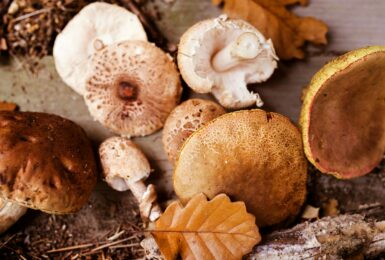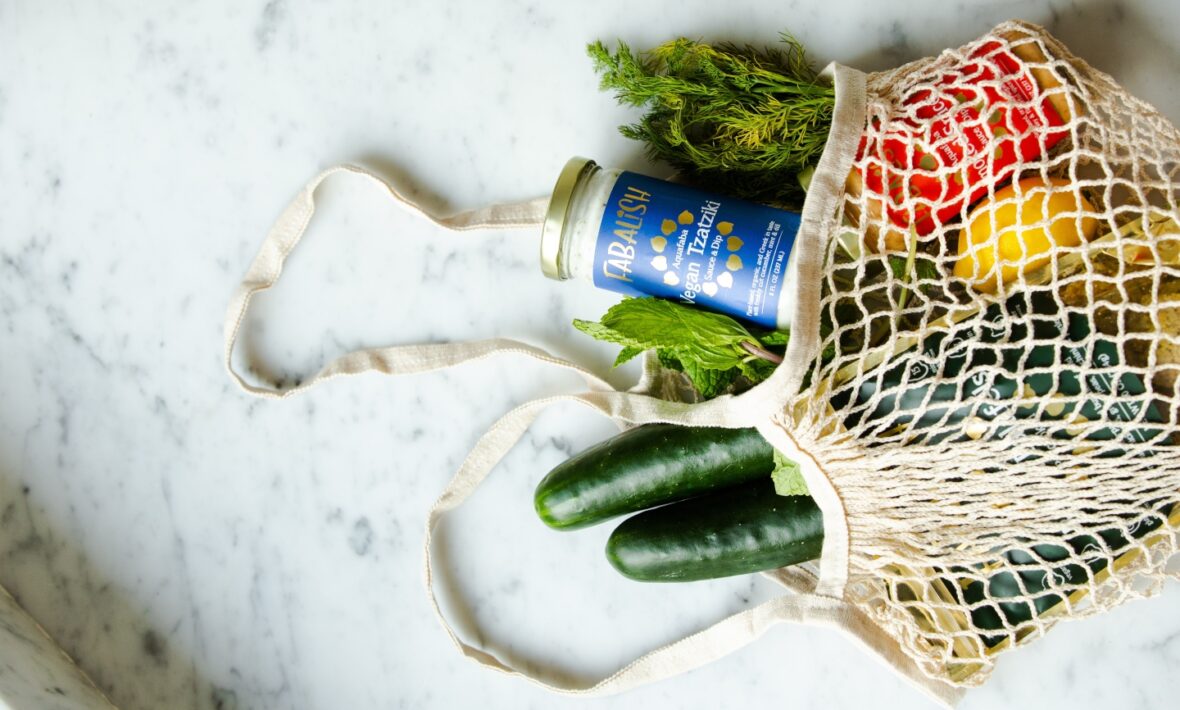
As a company, and as citizens of this lovely world we live in, the Contiki team has been on a mission to make our lives a little more sustainable whenever we can. You may have even seen our 5-year Sustainability Strategy focused on 11 goals, aimed to address our environmental footprint and community impact. So, leading up to World Environment Day, we wanted to focus a bit more on the zero waste mission, and how we can all do our parts to reduce our waste production while we’re at home.
We’re surrounded daily by unrecyclable materials and excess packaging, and each purchase is a potential contributor to the problem. Most of us add excess waste to our garbage bins on a daily basis, and there are so many little adjustments we can make to change that. So, we tasked our Sustainability Officer, Tasha Hayes, with a week-long mission: to try a different waste hack each day, for 7 days straight.
Here’s how Tasha’s week went, including some helpful tips you may want to try out on your own sustainability journeys:
Day 1: Order a Veggie Box
Tasha’s very first mission was something so many of us really look forward to right now: getting a package delivered. Tasha ordered a weekly veg box from Riverford Organic Farmers, who delivered a selection of seasonal veggies and eggs right to her door, all in completely compostable and recyclable packaging.
You can customize your box size based on your household, and it encourages you to eat with the seasons. Another bonus? The box system almost makes you feel as though you’re on a cooking show, and you challenge yourself to use and prepare the veg provided in exciting new ways.
There are other great companies like OddBox that send you surplus fruit and veg items deemed not pretty enough for the supermarket. This also helps save the amount of food thrown away.
Pros: Less packaging than the supermarket, and produce lasts longer as it’s straight from the farm, plus you’re supporting local farmers rather than buying imported produce.
Cons: These boxes aren’t available in all places, and can be pretty pricey to purchase.
Alternatives: If a veg box company isn’t available in your area, check out local farmer’s markets or shop at veg/fruit shops that try and source food locally and without plastic.
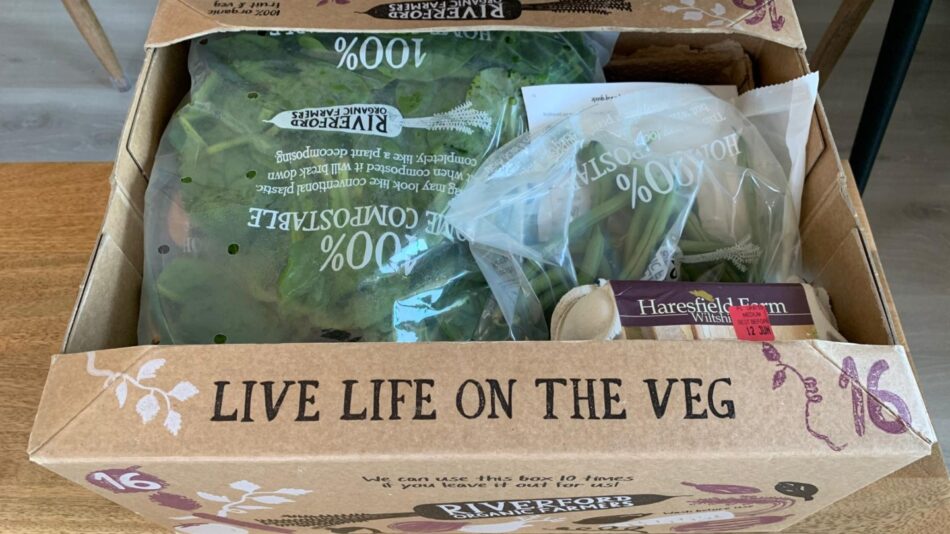
Day 2: Grow your own veggies and herbs
It may seem like a fantasy for many of us to walk through our own orchards and pick our own fresh produce, but it’s definitely possible, even on a smaller scale. Tasha’s second mission was to put her green thumb to use and make the most of her outdoor space, by growing her very own food.
The aim of this hack is that when you grow your own, you pick and use only what you need that day, instead of buying a whole packet that then might go to waste and end up in the bin. The produce is also organic, and there’s no plastic packaging in sight! Plus you can have fun with it and grow whatever you want, and it’s fun to watch your greens grow along the way.
Tasha really ran with this and created her own little oasis of tomatoes, onions, peppers, lettuce, and herbs. We can’t wait to see those babies sprout and flourish in her urban oasis.
Pros: Pick only what you use that day, less water used, zero waste required, and it’s more cost-effective to grow your own.
Cons: Time-consuming and involves planning ahead, requires outdoor space, trickier for colder climates.
Alternatives: Fruits and veggies are tricky but herbs are easy to plant and grow, even indoors in small planters. Try basil, chives, parsley and your other herbaceous faves.
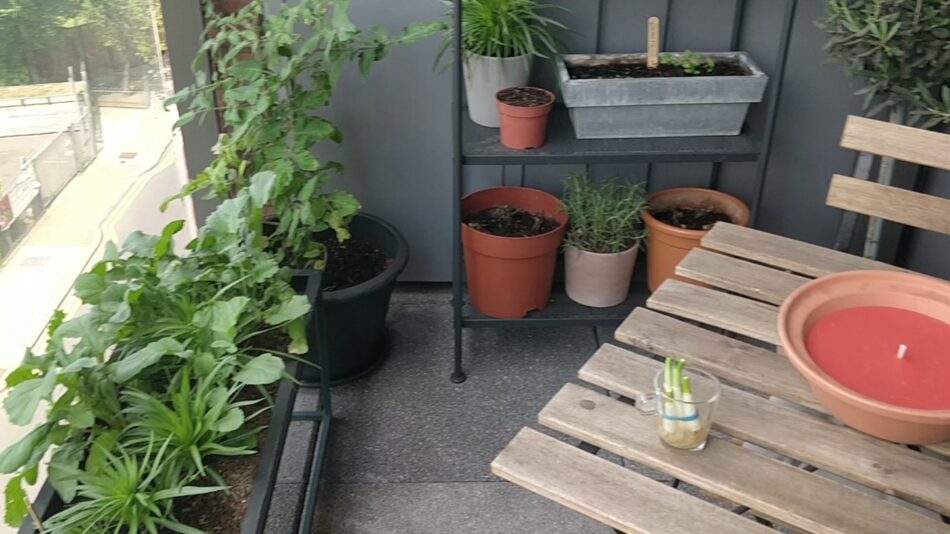
Day 3: Try Wormery / Composting
Now this one isn’t the most squeamish-friendly, but, stick with us… Tasha’s third-day mission was to try out composting, and more specifically vermicomposting with Wiggly Wigglers. Composting in general goes hand in hand with zero-waste living, as just throwing out your food scraps isn’t the best method. Many people don’t know that organic waste which ends up in landfill doesn’t break down. This is due to the fact that it is so tightly packed with other non-organic waste, that the decomposition process never starts. According to Permaculture News, 20%-30% of the waste that ends up in landfills should have been composted.
Using a wormery or vermicomposting (that is its fancy name) to compost waste is different from other composting methods as, yep, you guessed it, there are worms involved. A basic wormery can be two boxes stacked on top of one another. The top box would need a lid and air holes. The worms are fed the organic waste, which they nibble on. They then produce ‘worm tea’ (basically urine), which is collected at the base of the wormery.
The worm tea is AMAZING for plants and can be diluted in a watering can. The worms also produce nutrient-rich compost, which Tasha is intending to use for her urban garden.
Pros: Great for your garden/ plants, even better for our landfills.
Cons: Can be a bit messy, smelly, and not great for worm-ophobes. Initial set-up costs can be pricey in order to purchase the composter.
Alternatives: Collect your organic waste to drop off at a composting site nearby, or utilize the green bin/ composting program of your local waste management department if applicable.
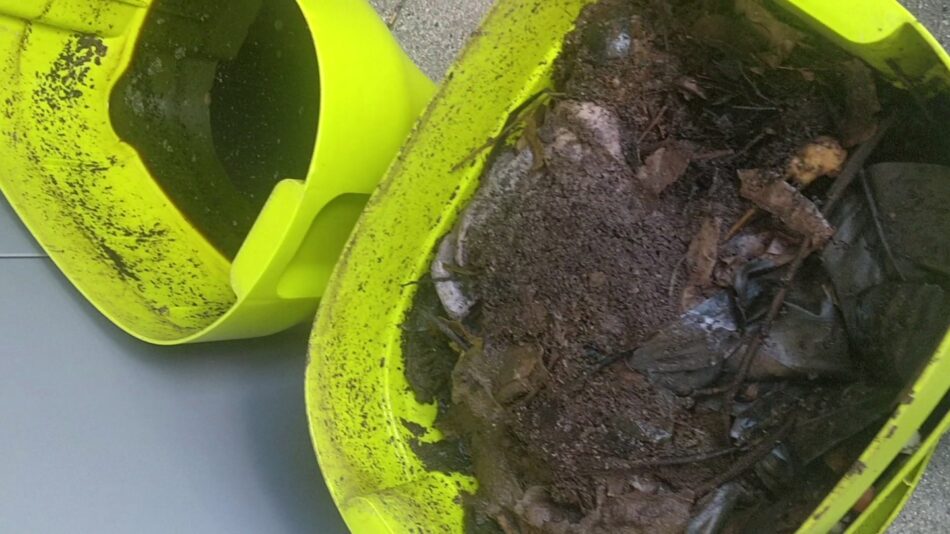
Day 4: Shop at Fill-Up Stores
As we’ve seen, there are a few fun hacks to de-waste your fruit and veg haul, but where things get more complicated is with all of the other goodies we eat on the daily. So, for day 4, Tasha’s task was to shop only at stores where she could fill up her own packaging and go plastic-free.
The rise of zero-waste or plastic-free shops is the opposite of a classic supermarket experience. They are designed to help tackle food waste and plastic waste by removing packaging from all their products. Tasha shopped at a local store called Bring Your Own, which sells organic-focused grains, nuts, dried fruits, pickles, and spices, all without the plastic wrapping. Plus, they even sell household goods, like cleaning products, body care, and beauty essentials.
At fill-up stores like this, shoppers bring their own reusable containers and use the weighing scales to buy just the amount they need – helping to reduce your environmental footprint and cut down on food waste. And a bonus: keeping everything in matching jars in your pantry is very on-trend with the current Tik Tok organizing esthetic.
Pros: Buying in bulk is often cheaper, and less food goes to waste as you only buy what you need, plus there’s zero waste in the packaging. The food is also generally healthier and made with wholesome, local ingredients.
Cons: Carrying empty containers to the store can be cumbersome, and these stores aren’t everywhere… yet. Selection is also currently limited in terms of what you can buy this way, compared to typical stores.
Alternatives: Bring your own reusable packaging to participating grocery stores, as more and more of them are allowing this for certain items.
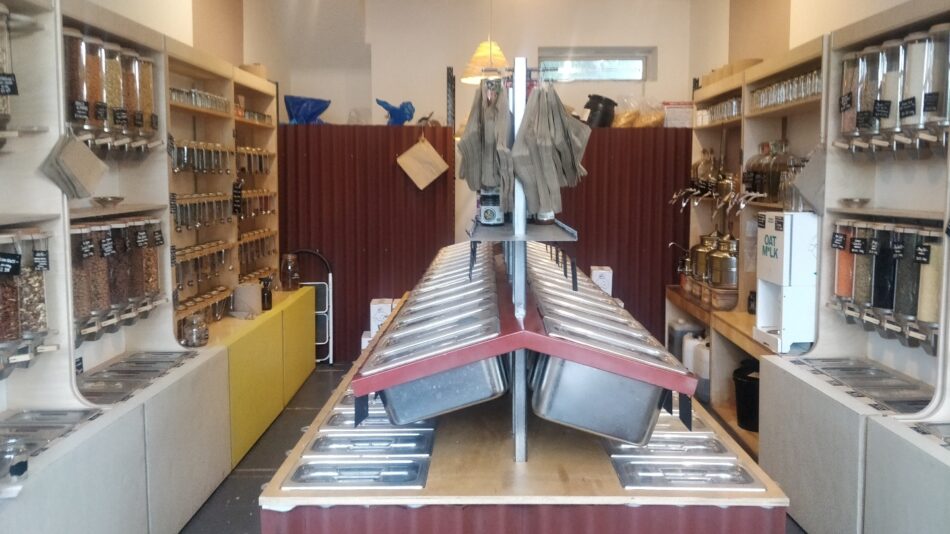
Day 5: Cook with No-Waste Recipes
We get it, some of us are a little most particular about our food… Some of us prefer white meat, or like the crust cut off of our sandwiches – to each their own. But pickiness leads to wastefulness, and we can learn a lot from communities and cultures who pride themselves on not wasting any part of an animal or plant.
Tasha’s fifth task was to cook with recipes that used every part of the vegetable, and her target vegetable was broccoli. Broccoli stalks (and the stalks of similar veg) are usually thrown away without a second thought. What most people don’t realize is that the stalk is full of goodness and can be just as tasty as the florets. The stalk can be cut into matchsticks and added to stir-fries, or also makes a great base for a quick broccoli soup, so Tasha did just that.
Turns out, you can find recipes to do this with a lot of produce. Kale stalks are often too tough for recipes and are therefore discarded, but instead of wasting them, you can turn them into a great pesto. Just blitz up the kale stalks instead of using basil to make a tasty pesto using the entire vegetable and no waste. Also, if you buy carrots with green carrot tops, then this is another option for a zero-waste pesto.
Another item often discarded without thought is the leaves from cauliflower. Just like the cauliflower stalk can be used, the leaves are also edible and full of nutrients. You can use cauliflower leaves as a side dish instead of spinach, kale or chard. You can also just roast them and dress them with some oil and salt.
Pros: Less food waste for the landfills.
Cons: It may take some creativity and extra time to research to find recipes, but it’s worth a try!
Alternatives: Be sure to compost the food components you’re not using, or find them a second home with soup-makers and crafty cookers you know and love.
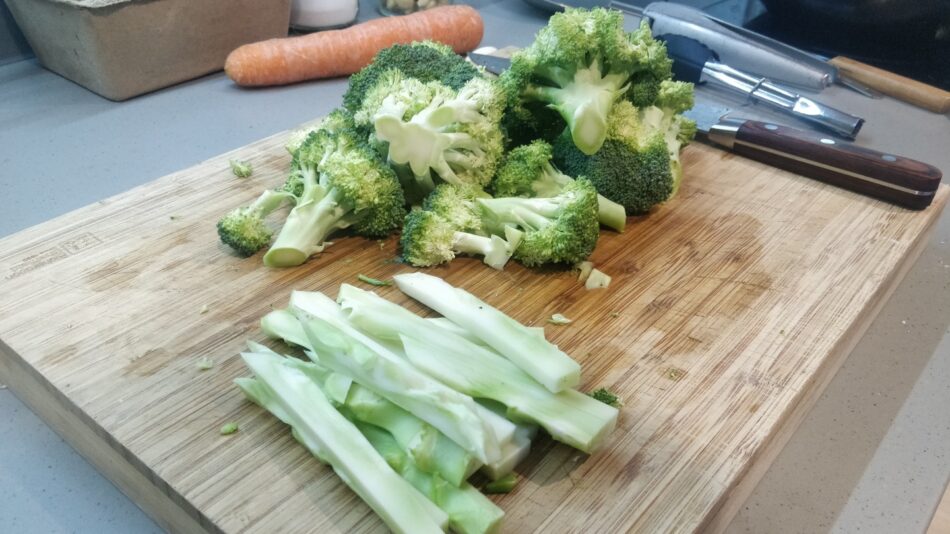
Day 6: Meal Planning
Meal planning is one of the most effective ways to reduce your food waste and save some money. Setting aside a little bit of time each week to plan your menu and create a shopping list makes the rest of the week a breeze. Planning properly also eliminates aimlessly walking the aisles at the supermarket or buying that third ketchup when you can’t quite remember what is in your fridge. Plus, it’s always beneficial to do a quick survey of your cupboards, fridge, and freezer to understand what you already have and what you still need.
For Tasha’s challenge, she had visited her plastic-free shop to fill up on bulk grains, spices, oils, etc., so she had an assortment on hand. With her veg box coming on a Monday she was able to know what was arriving a week before, which gave her time to plan on the weekend. She then created some meals around what was in her veg box, and simply needed to pick up a few missing items to complete her meals.
While it took about 30 minutes or so to plan one day a week, it meant that for the rest of the week Tasha didn’t have to really think, as she had a number of meals to choose from with all the ingredients on hand. If you already have a lot of ingredients in your cupboard, you can create a challenge that sees you incorporating these items into your meals for as long as it takes to use everything up.
Meal planning also allows you to buy a few ingredients in bulk so that you can reuse them in a few meals throughout the week. Buying a bigger bundle of spinach instead of smaller ones can see you adding it to a curry, salad, and smoothie all in one week and will use less plastic.
Pros: Lower cost overall, as generally the bigger the size the less you pay per serving. Less plastic is used and there’s less food waste for the landfills as you buy what you need and will eat.
Cons: A bit time-consuming to plan out, and requires more storage space of food items for the week. Also doesn’t allow for as much spontaneity and indulging in mid-week cravings.
Alternatives: Opt to cook meals or use ingredients that freeze well, just in case plans change and a week of meal cooking doesn’t go as planned.
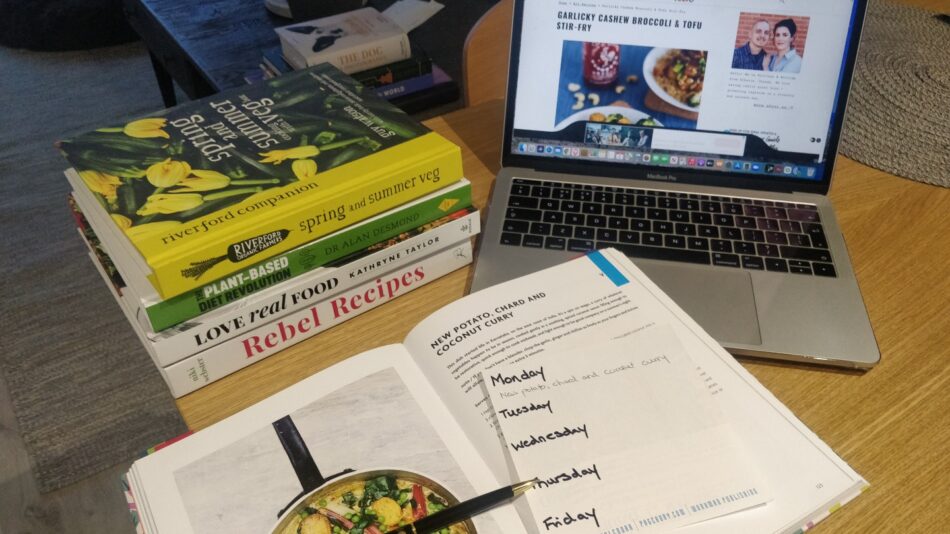
Day 7: Regrow Veggies from Scraps
After a successful week of experimenting, Tasha was able to combine a few elements of her mission into a final task. Day 7 combined her home-growing skills with some of the veg scraps from her box and will keep her on a waste-free mission for months to come. That’s one of the upsides of these zero-waste efforts; that so many elements of reducing waste can complement each other and work together to make an even bigger impact.
For the last day, Tasha aimed to reduce waste and save money by regrowing vegetables from her kitchen scraps. Some produce scraps are easier to just cook or compost, but things like spring onions are the easiest to try this with, and it really takes no effort at all. To regrow them, keep a good 1-2 inches of the spring onion base, making sure the roots are intact, and simply leave them in a small jar of water, making sure the roots are submerged. You can either leave them growing in water (just make sure to change the water every few days), or plant them in a planter box outside. Just make sure they receive some sunshine and of course water, and you will see your food scraps come back to life to provide you with more food!
Once you’ve mastered the spring onion, try regrowing lettuce. Cut off the stem and again place it in water, making sure no more than two-thirds are submerged. Leave on a sunny windowsill and change the water if it starts to look a bit murky. Once you see some growth, feel free to replant outside in soil if you have space, or you can simply leave it inside to keep growing.
Pros: This is virtually free food as you don’t even need to buy the seeds or plants to start out. No plastic here either, just fresh veg.
Cons: Like Day 2, it’s time-consuming and involves planning ahead, requires outdoor space, trickier for colder climates.
Alternatives: Give small foods like leeks, herbs, and garlic a go. These options are great for those with little to no garden space, as you can regrow these vegetables on your windowsill or a small pot on your balcony.
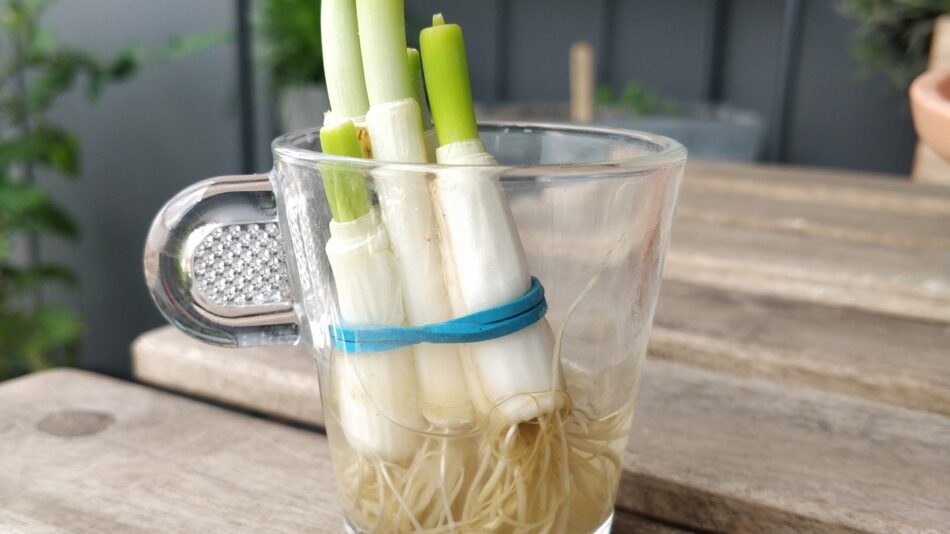
Final Thoughts
Not every hack is going to work for every person, but there is probably at least one thing that we can all change in our routines. And while going completely zero-waste is something that is currently unrealistic for most of us, every little bit of reduction helps.
Change may seem impossible, but as Tasha can attest to, some things aren’t as difficult as they seem. Trying it out for yourself is the key. There are brilliant people coming up with new sustainable hacks all the time, so if we can all try out what works for our lifestyles and be open to change, there’s hope for us yet.
Which hack was your favourite? Have more tips or sustainbility challenges you’d like to see us try? Leave your suggestions in the comments.




